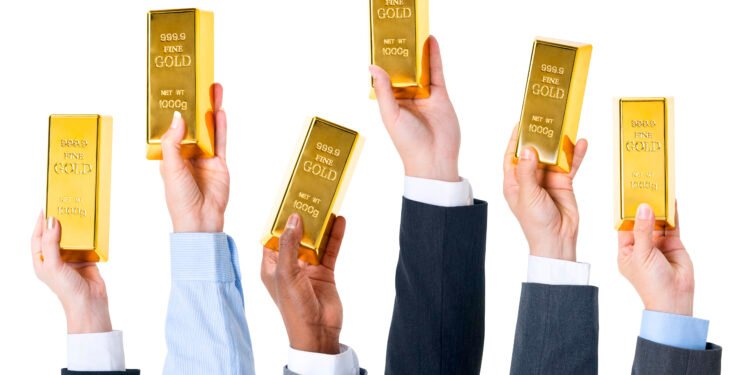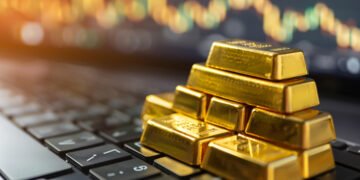The precious metals market has captured global attention as gold climbs to unprecedented levels, marking a significant moment in the ongoing evolution of safe-haven asset investing. Bullion has reached a remarkable record high of $3,819 per ounce, representing not just a numerical milestone but a broader reflection of the complex economic, political, and supply dynamics currently shaping global markets. This surge hasn’t occurred in isolation—it marks the sixth consecutive week of gains for gold and has created a ripple effect across the entire precious metals complex, lifting silver, platinum, and palladium alongside the yellow metal.
The Perfect Storm Driving Gold Higher
Multiple powerful forces are converging to push gold to these historic levels. At the foundation of this rally lies a weakening U.S. dollar, which traditionally moves inversely to gold prices. When the dollar softens, gold becomes less expensive for holders of other currencies, stimulating international demand. Additionally, a weaker dollar often signals concerns about U.S. economic strength or monetary policy, prompting investors to seek alternative stores of value.
The supply side of the equation is equally important. Gold markets are experiencing tightening conditions, meaning that available supplies aren’t keeping pace with demand. This fundamental imbalance creates upward pressure on prices as buyers compete for limited metal. Mining production hasn’t expanded sufficiently to meet growing appetite from various sources, including central banks, jewelry manufacturers, technology companies, and individual investors.
Political risk emanating from Washington has added yet another dimension to gold’s appeal. The U.S. capital faces significant uncertainty ahead of a crucial meeting between congressional leaders and President Donald Trump. The stakes of this meeting are substantial—failure to reach agreement on a short-term funding deal could trigger a government shutdown. Such a shutdown would have immediate practical consequences, including the potential delay of Friday’s employment report, which is one of the most closely watched economic indicators that influences Federal Reserve policy decisions and broader market sentiment.
Investment Flows and Central Bank Demand
The institutional investment landscape for gold has shifted notably in recent months. Gold-backed exchange-traded funds (ETFs) are experiencing fresh inflows, meaning investors are actively purchasing shares of these funds, which in turn must buy physical gold to back those shares. This mechanism creates direct demand for bullion and represents a vote of confidence from both retail and institutional investors who use ETFs as convenient vehicles for gaining gold exposure.
Perhaps even more significant is the continued robust demand from central banks worldwide. Central banks—the institutions responsible for managing national monetary policy and foreign exchange reserves—have been substantial buyers of gold in recent years. This trend reflects several motivations: diversification away from dollar-denominated assets, preparation for potential currency crises, and the desire to hold assets that carry no counterparty risk. Unlike bonds or other financial instruments that depend on another entity’s promise to pay, physical gold has intrinsic value and cannot default.
The combination of ETF inflows and central bank accumulation creates powerful and sustained demand that supports higher prices. Central banks, in particular, tend to be patient, long-term holders rather than short-term traders, meaning the gold they purchase is effectively removed from available supply for extended periods.
Monetary Policy Uncertainty and the Federal Reserve
The Federal Reserve’s policy outlook represents a critical variable for precious metals prices. Gold, which pays no interest or dividends, becomes more attractive when interest rates are low or falling because the opportunity cost of holding it decreases. When bonds and savings accounts pay minimal returns, gold’s lack of yield becomes less of a disadvantage relative to these alternatives.
Current economic data is creating meaningful uncertainty about the Fed’s next moves. Softer employment data could strengthen the argument for the Federal Reserve to implement interest rate cuts as soon as October. Weaker job growth suggests the economy may be cooling, which could prompt the Fed to ease monetary policy to support economic activity and prevent recession. However, Federal Reserve officials remain divided on both the timing and the pace of any potential easing measures. Some officials may favor moving quickly to support the economy, while others might prefer a more cautious approach to ensure inflation remains under control.
This internal division within the Fed adds to market uncertainty. Investors must navigate conflicting signals and prepare for multiple potential scenarios, which naturally increases demand for assets like gold that can serve as insurance against various outcomes.
Political Tensions and Fed Independence
Adding another layer of complexity, political tensions have emerged regarding the Federal Reserve’s independence—a cornerstone principle of modern central banking. Fed Governor Lisa Cook has publicly challenged President Trump’s reported efforts to remove her from the Federal Reserve Board. This confrontation raises fundamental questions about the separation between political leadership and monetary policy decision-making.
The Federal Reserve’s independence is considered essential for maintaining credible, effective monetary policy. When central banks are subject to political pressure, markets worry that policy decisions might be made to serve short-term political goals rather than long-term economic stability. Any perception that this independence is eroding can undermine confidence in the currency and push investors toward alternative assets.
Barclays strategists have weighed in on these dynamics, arguing that gold continues to trade at attractive relative value compared to both U.S. Treasury bonds and the dollar itself. Their analysis suggests that gold may be carrying a premium—trading at higher prices than fundamental supply and demand alone would dictate—specifically because investors are paying extra to hedge against risks to Federal Reserve independence. This premium reflects insurance value: investors are willing to pay more for gold today to protect against the potential consequences of politicized monetary policy in the future.
The Broader Precious Metals Rally
While gold captures most headlines due to its status as the premier safe-haven asset, the rally extends across the entire precious metals complex, with some metals posting even more dramatic gains in percentage or milestone terms.
Silver has climbed to $46.90 per ounce, reaching its highest level since 2011. Silver occupies an interesting position in commodity markets because it serves both as a monetary metal (similar to gold) and as an industrial metal used extensively in electronics, solar panels, photography, and various manufacturing applications. This dual nature means silver responds both to safe-haven demand and to expectations about industrial activity and technological advancement. The current rally suggests both factors are in play—investors are seeking safe havens while industrial demand remains solid.
Platinum has broken above $1,600 per ounce for the first time in more than a decade, representing an extraordinary milestone for this metal. Platinum’s primary applications include automotive catalytic converters, jewelry, and various industrial processes. The metal has struggled for years as diesel vehicles (which use more platinum in their emissions systems than gasoline vehicles) fell out of favor and as palladium prices rose so high that some manufacturers substituted away from platinum. The current breakout above $1,600 suggests either a fundamental reassessment of platinum’s supply-demand balance or growing safe-haven demand spilling over from gold.
Palladium has risen nearly 3% recently, touching its strongest level since July. This metal, used primarily in catalytic converters for gasoline-powered vehicles, has experienced extreme volatility in recent years due to very tight supplies concentrated in just a few producing countries, particularly Russia and South Africa. Market deficits—situations where consumption exceeds production—have been deepening, creating structural tightness. Additionally, lease rates for palladium have surged, indicating that users who need the physical metal for manufacturing are struggling to secure supplies and are willing to pay premium rates to borrow it.
Supply Constraints and Geopolitical Considerations
The structural tightness affecting precious metals markets extends beyond immediate supply-demand imbalances. Citigroup analysts have highlighted an additional potential complication: President Trump’s Section 232 investigation into critical minerals. Section 232 refers to a portion of U.S. trade law that allows the president to impose tariffs or other restrictions on imports deemed to threaten national security.
If this investigation leads to action, palladium could potentially become subject to tariffs as soon as October. Such tariffs would further strain already tight markets by making imported palladium more expensive for U.S. manufacturers. This could force difficult choices: pay higher prices, reduce usage of palladium in manufacturing, accelerate substitution to other materials, or relocate production outside the United States. Any of these responses would create additional market distortions and potentially push prices even higher.
The critical minerals investigation reflects broader tensions about supply chain security and dependence on foreign sources for materials essential to key industries including automotive manufacturing, defense, and technology. Russia’s dominant position in palladium production creates particular concerns given geopolitical tensions, as supply disruptions could have significant economic consequences.
Gold’s Role as a Defensive Asset
Against this backdrop of dwindling supply, geopolitical risk, political uncertainty, and monetary policy questions, precious metals continue to demonstrate their enduring appeal as defensive assets. Defensive assets are investments that tend to hold their value or even appreciate during periods of economic stress, political turmoil, or market volatility—times when traditional growth-oriented investments like stocks may struggle.
Gold’s 6,000-year history as a store of value provides deep psychological comfort to investors facing uncertain times. Unlike paper currencies that can be printed in unlimited quantities or corporate bonds that depend on a company’s solvency, physical gold has intrinsic value, finite supply, and no counterparty risk. These characteristics make it particularly attractive when trust in governments, central banks, or financial institutions comes into question.
The current rally reflects not just one or two favorable factors but rather a convergence of multiple supportive elements: a weakening dollar reducing the cost for international buyers, supply constraints limiting available metal, political uncertainty in Washington creating governance concerns, questions about Federal Reserve independence undermining confidence in monetary stability, potential policy shifts that could lower interest rates and reduce the opportunity cost of holding non-yielding assets, and robust institutional demand from both central banks and ETF investors.
Looking Forward
The precious metals market faces continued uncertainty in the weeks and months ahead. Key questions remain unresolved: Will Congress and the President reach agreement on funding to avoid a government shutdown? How will employment data evolve, and will it prompt Federal Reserve action? Can the Fed maintain its independence amid political pressures? Will the Section 232 investigation lead to new tariffs on critical minerals? How will supply constraints evolve as mining companies attempt to increase production?
What seems clear is that the factors supporting higher precious metals prices remain firmly in place. As long as uncertainty persists across political, economic, and monetary policy dimensions, investors are likely to maintain significant allocations to gold, silver, platinum, and palladium as insurance against adverse outcomes. The historic price levels being reached aren’t just numbers—they’re reflections of genuine concerns about the stability of traditional financial systems and the preservation of wealth in an increasingly uncertain world. Whether these prices represent a temporary spike or a lasting shift to a new higher price range will depend on how these various uncertainties resolve in the coming months.
Acknowledgment: This article was written with the help of AI, which also assisted in research, drafting, editing, and formatting this current version.







